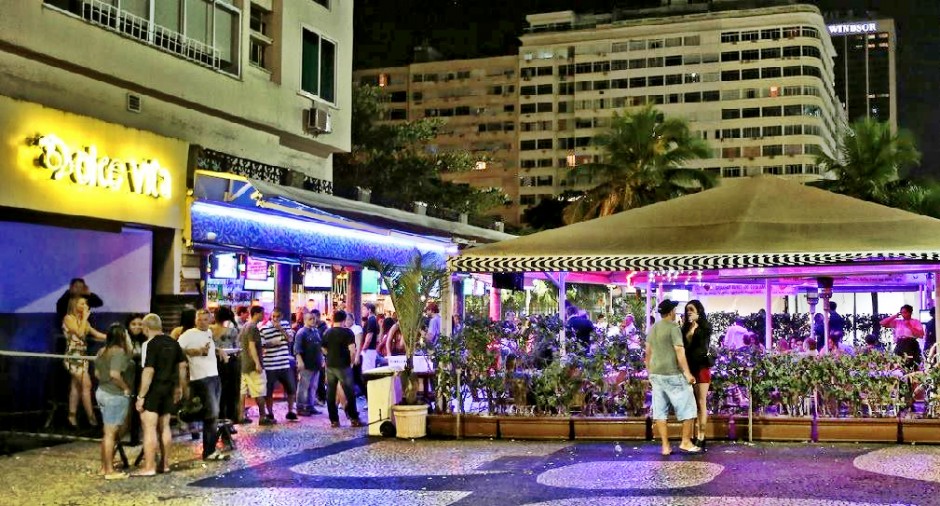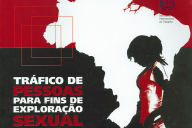Anthropologist Thaddeus Blanchette and historian Cristiana Schettini provide a history of Rio sex in their 2013 paper, Sex Work in Rio de Janeiro: “More than tolerated – effectively managed”.
Published to RED LIGHT RIO in six parts, the paper situates Rio’s red light district on the larger map of sex venues in Rio, and in the broader historical context of Rio’s extra-legal regulation of a profession that is not illegal in Brazil.
Part I is a history of sex in Rio.
Part II discusses the fuzzy legality of prostitution in Rio.
Part V presents eviction maps of sex venues in Copacabana Beach and downtown Rio.
This final section concludes: “With a new wave of urban renewal and “hygienization” taking over the city in preparation for the 2014 World’s Cup and the 2016 Olympic Games, it seems that Rio de Janeiro is once again on the cusp of a transformation in how its public authorities deal with prostitution: everything indicates that another crackdown, similar in scope and severity to those of 1943, 1959,or 1970-71, is on the way.”
Trafficking of women and immigration
Many 19th and 20th century carioca prostitutes maintained relationships with men they considered to be their husbands, a fact which continues to be the case today. These relationships could and often were considered to be instances of pimping by the police. The borders between relationships considered to be socially acceptable and those understood to be abusive were – and are – quite tenuous, both among prostitutes and among carioca women in general.
Within this general scenario, reports of trafficking in women have historically tended to homogenize a great variety of circumstances and social experiences according to one single narrative which has as its central axis affirmation of the essential vulnerability and victimization of female sex workers.
Historically, tales of trafficking have revolved around the figure of the European (and particularly Jewish) immigrant supposedly brought to Rio or Buenos Aires on false promises by a male recruiter, only to be forced into sex work as slave. Today’s narrative inverts the flow and nationality of the presumptive victims.
Now, trafficking stories generally presume that the victim is a mixed-race or black Brazilian ingénue, tricked into going overseas by unscrupulous foreign “false princes” who likewise enslave her as a forced prostitute. In both cases, the narrative situates the presumptive trafficking victim as sexually inexperienced, utterly agencyless and completely cut off from any outside contact or the possibility of intervention, unless it be through armed agents of the state.
Studies of prostitute immigration in late 19th and early 20th century Rio de Janeiro complicate this rather simplistic and dramatic reading. There are significant, although necessarily fragmented, indications that these women maintained family ties and raised children while working as prostitutes. It’s hard to trace these arrangements, however, in large part due to the symbolic weight and wide distribution of “white slavery” stories.
In general, these stories served to express anxieties regarding the changes and instabilities at loose in the world in the late 19th and early 20th century and, in particular, the increasing mobility of women, which often took them far beyond the view of their immediate family.
In Rio de Janeiro, however, trafficking stories took on specifically local meanings. The mobilization of a vocabulary connected to the abolition struggle in order to denounce the sexual exploitation of European women gained peculiar resonances in a context in which chattel slavery was, in fact, being dismantled.
In Rio during the 1870s, the figure of the prostituted black slave and that of the recently disembarked European “white slave” served similar discursive purposes. Both types of women were represented by their contemporaries as completely stripped of all subjectivity. Both were compared to machines and popular discourses surrounding them tended to salient their supposed feminine fragility as well as the violence and immorality of slavery. These sorts of representations, of course, legitimized police intervention over relationships that were private, at least in principle, but whose essential immorality was understood to demand state intervention.
Slave prostitution in the 19th century, however, did not necessarily imply a huge separation between slave prostitutes and the rest of society – or, indeed, between slaves and their masters. It was fairly common for slave owners (who were often themselves poor free – or recently freed – women), to establish agreements with their slaves whereby the latter would engage in prostitution but would otherwise live an autonomous life as long as they paid their owner a daily cut of the profits. Often, both owner and slave would live under the same roof, with the owner also working as a prostitute. The pair would commonly engage in other forms of labor as well, such as selling fruits and vegetables in the streets or working as domestics, cooking and cleaning.
In 1871, in the midst of the intense debate regarding the abolition of slavery, a Police precinct captain opened up a series of cases involving slave prostitutes. Brazilian law at the time was based upon the Roman principal that the prostitution of slaves was an “illicit and immoral use of property”, which could result in the forfeiture of that property.
The cases of the “slave prostitutes” had a great impact upon the public debates surrounding abolition. They were also significant in that they mark the first intervention of public power into the organization of sexual commerce in Rio de Janeiro.
The slaves in question were freed after testimony provided by clients and neighbors, but the prominence of these cases in the 1870s ended up sinking any municipal project for the regulation of prostitution, given that sex work had become inextricably linked with slavery in the public mind.
Local authorities’ persistent reluctance to openly regulate prostitution must be looked at within this context. By and large, the Brazilian elite in the late 19th century were seeking to eliminate slave labor without hurting the entrenched interests dependent upon it.
As feminist and reformist anti-prostitution campaigns grew in the United States and Great Britain, the idea that regulationist countries ended up favoring the development of “white slavery” became ever-more popular in Brazil. The idea that the State should intervene in order to regulate another form of commerce, also widely understood as immoral and degrading was thus unacceptable to many policy makers of the time.
One of the consequences of this in Rio de Janeiro was that the movement of single women from Europe to South America became almost entirely interpreted as forced migration: always trafficking and never immigration.
The establishment of the crime of lenocínio, the laws providing for the expulsion of foreigners of 1907 and the successive investigations by the carioca police created a wave of persecution of poor foreigners, who were now seen as suspect. In 1921, writer Lima Barreto commented on the carioca police’s taste for persecuting foreigners, claiming that police considered “every foreigner with a strange name” to be a pimp and thus someone who should be deported.
Court and police documents regarding the deportation of foreigners accused of pimping and the trials of supposed procurers offer us a rich and varied record of affective relationships and agreements which occurred between these people and prostitutes. Often, the cases came to the attention of authorities due to the denunciations of the “slaves” themselves who showed up in the precinct houses with accusations of exploitation.
The motivation behind this could range from complaints regarding rents that were considered to be exorbitant (the reason behind a large portion of the cases of lenocínio in the 1890s) to women’s attempts to defend themselves from abusive and violent partners, some of whom seemed to approximate the popular stereotype of the foreign pimp.
Following the decline in foreign immigration after the Second World War, accusations of “trafficking in women” in Rio de Janeiro almost disappeared, only to be reactivated in the early 21st century.
After the terrorist attacks on the United States in 2001 and the subsequent closing of the borders of the so-called “developed nations”, the figure of the immigrant prostitute slave again began to gain new currency in the Brazilian media and among policy makers. As in the early 20th century, today’s moral panic around trafficking seems to reflect anxieties over the increased global mobility of working class women. This time, however, it has principally focused on black and brown Brazilian women who, during the 1990s, traveled to Europe, Japan and North America in significant numbers in order to work (among many other things) as prostitutes.
Extensive ethnographic work by Adriana Piscitelli in Spain and the Brazilian northeast and by Blanchette and Silva in Rio de Janeiro and São Paulo has shown that the affective relationships and agreements which Brazilian immigrant sex workers enter into with foreign men are extremely varied and complex and cannot be reduced to a homogenized narrative of Brazilian victims and foreign villains.
More importantly, it has shown that there are no necessary, institutional linkages between sexual tourism, trafficking in women and the sexual exploitation of children – three topics that the Brazilian media and policy makers generally consider to be synonymous. Meanwhile, Marina Pires de Oliveira has shown that a significant number of anti-trafficking cases brought before judges in Brazil are properly anti-vice cases, using the rhetoric of sexual slavery to close down brothels or nightclubs.
Family and affective arrangements among prostitutes have historically been quite varied in Rio de Janeiro and have often involved men and women whom authorities have labeled as “pimps” or “traffickers”. Many of these relationships survive police attempts to spatially and socially segregate prostitution from polite society through “extra official regulation”.
Constant police harassment and Brazil’s non-regulationist stance has ensured, however, that prostitutes and their partners, friends and families are involved in constant negotiations with the police. As we enter into the second decade of the 21st century, this situation does not appear to have changed.
Conclusion: Society and prostitutes in Rio de Janeiro
The absence of prostitution regulation in Rio de Janeiro should certainly not be understood as the result of the State inaction regarding sex work. Instead, it should be construed as a policy of putting the largest amount of control possible over prostitution in police hands.
By not defining prostitution as illegal and not legally regulating it, the Brazilian state has decided to leave every day decisions regarding sex work and its conflicts up to individual precinct captains and the cops on the beat, who apply their own personal understandings, prejudices and interests to the situation in accordance with whatever fashions appear to be current in the surrounding society.
The peculiar Brazilian system was defined throughout the 20th century through the growing institutionalization of “muddling along”. While this systematically employed non-system gave police a notoriously wide scope of action when dealing with prostitutes, it also gave the sex workers more space for maneuver and negotiation than was perhaps possible in urban contexts in other countries – or, indeed, in less metropolitan spaces within Brazil itself.
In 1915, Police Chief Aurelino Leal neatly resumed what he believed had become the dominant tendency in the country with regards to prostitution. Leal claimed that the police were empowered to legitimately exercise a preventive role regarding prostitution and were given a certain degree of leeway in their choice of what measures where to be used in this role (measures which may or may not explicitly be delimited by laws and regulations). These measures included the power to decide where and when prostitution could be exercised in the city.
As we have seen, this idea was translated into the constantly repeated decrees that prostitution be removed from this or that part of the city, beginning with the prohibition of “window prostitution” in downtown, moving through the attempts to concentrate prostitutes in Lapa and the Mangue, the later drives to demolish these two regions, the efforts to “moralize” prostitution in the port, keep it out of Copacabana and, indeed, stretching up to the current day in which the various precincts and the Rio de Janeiro state prosecutor’s office seem to consider themselves empowered to eliminate any bar or establishment where prostitution might be occurring – especially if said venue occupies land needed for “improvements” scheduled for the 2014 World’s Cup and the 2016 Olympics.
The ebbing and swelling of repressive actions of the police can be charted via the repeated habeas corpus requests on the part of prostitutes, a tendency that began in 1896 with the first large-scale police persecutions of sex workers and continues up to the present date, with the reaction of brothel employees to the mass arrests which took place in anti-prostitution raids in 2005.
The degree to which judges grant or reject these pleas can be seen as a measure of the degree of social tolerance for prostitution in Rio de Janeiro at any given time. Thus, in the 1930s, judges began to reject habeas corpus requests made by prostitutes almost as a matter of course and the women working in the delimited zones of Lapa and the Mangue, as a consequence, became ever more vulnerable to the repressive actions and blackmail of police authorities.
With the liberalization up of Brazilian culture and society from the late 1970s to the early 2000s – and particularly following the end of the military dictatorship in 1985 – it became increasingly difficult to openly repress prostitution and habeas corpus requests tended to be granted. This reduced the possibilities for police abuse of prostitutes, which had been intense and notorious during the immediately preceding military regime.
From the end of the military dictatorship on to the present day, however, the system of extra-official regulation of prostitution in Rio de Janeiro seems to have continued on largely intact, although in a less institutionalized and more personalized form, perhaps, than in the Mangue in the 1920s or ‘50s.
Ethnographic research carried out in Rio in recent years indicates that it is almost impossible for a large prostitution venue to function in the city without “oversight” by the police. Such involvement often takes the form of having a police officer as a “silent partner” of the venue’s owners, interceding in day-to-day conflicts with the neighbors or local administrative authorities and guaranteeing the “moralization” of the house by keeping its activities quite quiet and indoors. The police officers in question often get a cut of the venue’s profits for their service.
In recent years, however, police involvement in the administration of prostitution has once again come to be seen as corruption by the citizenry in general. In early 2012, a coordinated and unforeseen series of raids on Rio’s largest and most well-known commercial sex venues was carried out, closing several houses which had been functioning for some 30 years. These raids have been the largest anti-prostitution activities carried out by the carioca police since the expulsion of the remnants of the Mangue in 1979 and justified in part by the Rio de Janeiro State Prosecutor’s Office as a blow against police corruption.
With a new wave of urban renewal and “hygienization” taking over the city in preparation for the 2014 World’s Cup and the 2016 Olympic Games, it seems that Rio de Janeiro is once again on the cusp of a transformation in how its public authorities deal with prostitution: everything indicates that another crackdown, similar in scope and severity to those of 1943, 1959,or 1970-71, is on the way.
Meanwhile, however, it does not appear that Brazil is any more likely to resolve its legal ambivalence regarding prostitution now that it was in 1890, 1920, 1940, or 1970. If some of the ways and manners in which the country deals with prostitution have changed, others seem to resonate with the strategies currently employed by the city of Rio de Janeiro in its interventions in the sexual commercial market of the early 20th century.
On the one hand, prostitution has been legally codified as a job by the Federal Ministry of Labor and (at least until very recently) the Ministry of Health has worked with prostitutes and their political organizations in HIV and STD prevention. On the other hand, the recent global panic regarding trafficking of persons has pressured the Brazilian federal government to adopt an ever-more active and draconian stance against the migration of sex workers, given that the only legal definition of “trafficking” in the Brazilian penal code understands the crime as aiding and abetting the movements of people engaged in prostitution.
In light of this problem, in mid-2012, a Congressional Judicial Committee called to review a new bill reforming Brazil’s anti-trafficking laws attended to the requests of the prostitutes’ movements and suggested that the crime of “trafficking” be once and for all conceptually separated from prostitution. The jurists, in fact, went one step farther and suggested that certain parts of the laws regarding lenocínio be overturned in general. In support of their position, they argued that,
In fact, prostitution is not now and never has been a crime in Brazil.
Punishing the establishment of “houses of prostitution” and “procurement” is nonsensical if the sexual encounters in question are established by adults in accordance with their own free will. We thus propose to [decriminalize these conducts]. What is important is that we only punish sexual exploitation. It does not matter where this occurs or who are the intermediaries. By creating this new type of “sexual exploitation”… the other figures referred to in the prostitution laws are revoked, ripping the veil of hypocrisy and freeing women from shameful stigma.
While the jurists’ proposal does not completely do away with the crime of lenocínio (for, after all, what exactly is “sexual exploitation”?), it does at least take a step in the direction of recognizing that sex work, freely engaged in by adults, should not be criminalized or stigmatized.
Predictably, the religious right and certain sectors of the feminist left in the Brazilian congress are dead set against the proposed changes and, at the present moment, there seems to be very little chance that they will be encoded as law. As these groups’ political opposition to prostitution has grown, the Federal Health and Labor Ministry’s – traditionally two of sex workers’ stauncher allies in government – have backed away from supporting prostitution as work.
In mid-2013, this revenge culminated in the Health Ministry’s censorship of its own HIV prevention campaign which linked prostitutes’ professional and self-esteem to safe sexual practices. The Labor Ministry is also now quick to point out that its “bureaucratic” classification of prostitution as a job doesn’t give people the right to engage in it.
Prostitution today in Rio de Janeiro can only be understood in the light of the tense negotiations that have marked the control of sexual commerce in the city of the last 200 years. Today, however, many sectors of carioca society – particularly the most wealthy and powerful – wish to once again reform the city as a showcase for Brazil during a period of intense international retrenchment with regards to immigrants’ and prostitutes’ rights.
As a result, city and state authorities are increasingly under pressure to remove prostitution from public view, especially in those areas of the city slated for rapid development in order to accommodate upcoming international sports megaevents. Predictably – and almost overnight – long-established prostitution venues are being raided, harassed and shuttered and the city’s sex workers are having to once again reformulate survival and work strategies in an increasingly unfavorable legal and economic environment, reinforced by often hysterical popular media reports that associate prostitution with trafficking of drugs and people and the sexual exploitation of children.
What the future will bring is, as of yet uncertain but one things is becoming increasingly clear: it is unlikely that faced with these new/old dilemmas regarding sex work, Rio de Janeiro will radically break with its traditional history of regulating prostitution through direct and extra-legal police actions.
Featured image: Balcony Bar, a hot spot for prostitution and sex tourism in Copacabana in 2012 (Thaddeus Blanchette)
This paper was given at a seminar at the International Institute of Social History as part of their Selling Sex in the City project. It will be published later this year as part of a book dealing with the history of sex work in several dozen global cities, and is republished to REDLIGHTR.IO with permission of the authors and the IISH.
—– References
81 Cristiana Schettini Que Tenhas Seu Corpo.
82 Ibid.
83 Sandra Lauderdale Graham “Slavery´s impasse: slave prostitutes, small-mistresses, and the Brazilian Law of 1871”, Comparative Studies in Society and History, v.33, n.4 (1991) pp.669-694.
84 Ibid, p. 675.
85 Ibid; Cristiana Schettini “Lavar, passar e receber visitas: debates sobre a regulamentação da prostituição e experiências de trabalho sexual em Buenos Aires e no Rio de Janeiro, fim do século XIX”, Cadernos Pagu, 25 (2005) pp. 25-54.
86 Lima, Barreto Diário do hospício/ Cemitério dos vivos (Rio de Janeiro, 1993); Lená Medeiros de Menezes 1Os Indesejáveis – desclassificados da modernidade. Protesto, crime e expulsão na capital federal (1890-1930) (Rio de Janeiro, 1996).
87 Cristiana Schettini Que Tenhas Seu Corpo.
88 Adriana Piscitelli “On ‘Gringos’ and ‘Natives’: Gender and sexuality in the contexto of international sex tourism in Fortaleza, Brazil” Vibrant, Ano1, V1 (2001); “Sujeição ou subversão? migrantes brasileiras na indústria do sexo na Espanha”. História & Perspectivas, Universidade Federal de Uberlândia, nº 35, Agosto-Dezembro (2006); Pesquisas em tráfico de pessoas (parte 3) (Brasília, 2007); “Entre as “máfias” e a “ajuda”: a construção de conhecimento sobre tráfico de pessoas”. Cadernos Pagu, #31, July-December. (2008); “As fronteiras da transgressão: a demanda por brasileiras na indústria do sexo na Espanha” Sexualidad, Salud y Sociedad – Revista Latinoamericana (Rio de Janeiro, 2009).
89 T. Blanchette & A.P. Silva, “Nossa Senhora da Help”; Thaddeus Blanchette, “’Fariseus’ e ‘gringos bons’: masculinidade e turismo sexual em Copacabana” Adriana Piscitelli, et al, orgs. Gênero, sexo, amor e dinheiro: mobilidades transnacionais envolvendo o Brasil (Campinas, 2011); Ana Paula Silva, “’Cosmopolitanismo tropical’: uma análise preliminar do turismo sexual internacional em São Paulo” Adriana Piscitelli, et al, orgs. Gênero, sexo, amor e dinheiro: mobilidades transnacionais envolvendo o Brasil (Campinas, 2011).
90 Marina Pires Oliveira “Sobre armadilhas e cascas de banana: uma análise crítica da administração de Justiça em temas associados aos Direitos Humanos”. Cadernos Pagu, #31, July-December (Campinas, 2008).
91 Aurelino Leal Polícia e poder de polícia (Rio de Janeiro,1918).
92 Julie Ruvolo “Rio’s Biggest Prostitution Crackdown in a Generation” The Atlantic: Cities 7/92012. At http://www.theatlanticcities.com/jobs-and-economy/2012/09/rios-biggest-prostitution-crackdown-generation/3199/ accessed on 12/12/2013.
93 Consultor Jurídico “Donos e empregados de bordel merecem tratamentos iguais.” 25.01.2005. Accessed at http://www.conjur.com.br/2006-jan 25/donos_empregados_bordel_merecem_tratamentos_iguais on 1.17.2006.
94 T. Blanchette & A.P. Silva “Sexo a um real”.
95 Waleska Borges “Três pessoas são presas na Zona Sul acusadas de incentivar a prostituição”. O Globo. http://oglobo.globo.com/rio/tres-pessoas-sao-presas-na-zona-sul-acusadas-de-incentivar-prostituicao-521317615/06/2012. Accessed on 7/07/2012; Julie Ruvolo “Rio’s Biggest Prostitution Crackdown”.
96 Adriana Piscitelli, “Brasil na transnacionalização do controle do trabalho sexual”. Presentation given at the LASA 2012 conference, San Francisco, May 2012.
97 Senado Federal Relatório Final da Comissão de Juristas para a Elaboração de Anteprojeto de Código Penal, criada pelo Requerimento nº 756, de 2011 (Brasília, 2012).
98 The same Judicial Committee suggests that “sexual exploitation” be redefined as “forcing someone to work as a prostitute or impeding them from leaving work as a prostitute”.
99 CLAM “Tempos de Censura” 6.6.2013, accessed at http://www.clam.org.br/destaque/conteudo.asp?cod=10594 on 12.12.2013.








[…] Read the conclusion of Blanchette and Schettini’s Sex Work in Rio de Janeiro: “More than tolerated – effectively managed” in Part VI: World Cup Sex Panic. […]